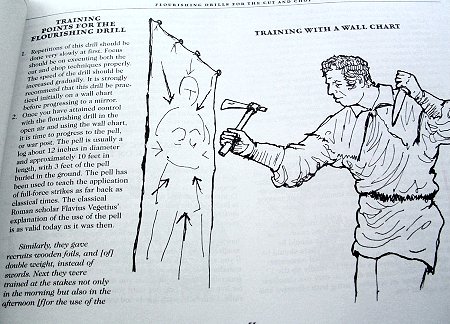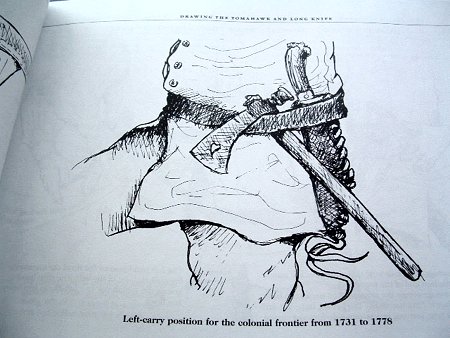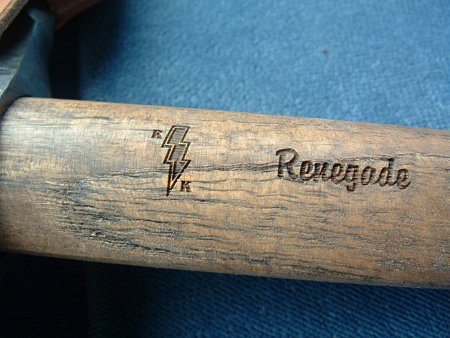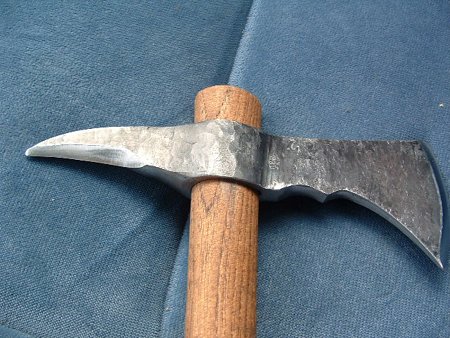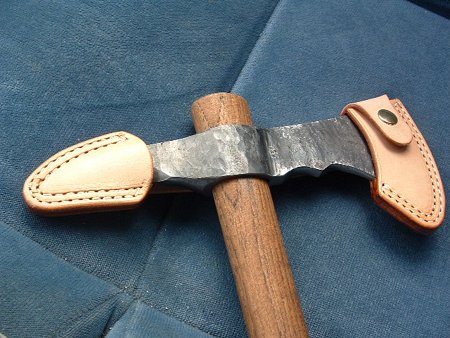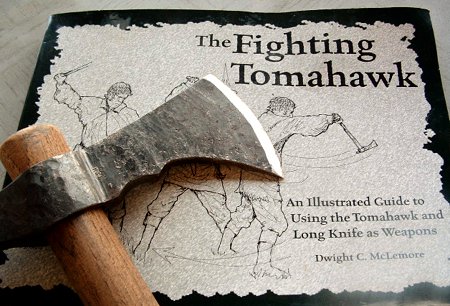its paid sponsors, whose products you need!
| Home |
| Intro |
| Current Issue |
|
Mailing List |
| Store |
| Strength |
| Subscriber Content |
| ARCHIVES
|
| Martialism |
| Pacifism |
| Q & A |
| Cunning-Hammery |
| Advertise With Us |
| Submit An Article |
| Staff |
| Discussion Forum |
| Links |
“Stay ‘unreasonable.’ If you
don’t like the solutions [available to you], come up with your
own.”
Dan Webre
The Martialist does not
constitute legal advice. It is for ENTERTAINMENT
PURPOSES ONLY.
Copyright © Phil Elmore,
all rights
reserved.
The Ranger Knives Renegade
Review by Lawrence Keeney
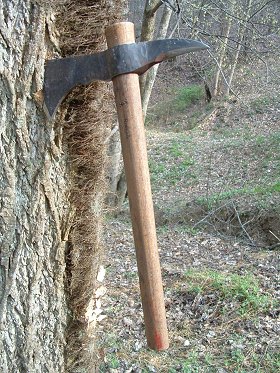
Remember, in the days of old, firearms were simple devices. Most were single shot rifles and pistols. Some seventy years before the invention of percussion arms, guns of that period were flintlocks. Sometimes the guns fired just fine, and sometimes they did not. If the user were at the wrong end of an assault by bandits, enemy soldiers or native Indians, this would be a supremely bad time to be left holding an unloaded rifle. The hawk, along with the fixed blade, were the backup weapons of the day. Through many years, Battle-savvy soldiers and militiamen developed tested close quarters battle tactics with edged weapons such as the tomahawk. These tactics were written down, and luckily, survive today.
A recent book from Paladin Press shows how useful the Tomahawk was to early settlers, but why the tool is an essential part of any Martialists edged weapon arsenal. The Fighting Tomahawk, by Dwight C. McLemore, chronicles the origins of the hawk, from its early genesis from the common hatchet to a fighting weapon. Using historical texts and drawings, the author shows how the tomahawk evolved from the common hatchet to a more useful and sometimes deadly tool. If a reader studies and practices using exercises in this book, he will attain a healthy respect for the utility of the hawk.
Strangely enough, the tomahawk didnt begin as just the white mans weapon. European traders bestowed them upon native Americans as gifts in the early days. Members of the various tribes became quite fond of the tools, which they called tamahaken, a term from the Algonquin tribe. In the following years, when scores of settlers came to these shores, there came a need for militias to protect the citizenry. While many British soldiers were issued swords for self- defense along with their muskets, the citizen soldiers were not. Swords were prohibitively expensive and not deemed necessary for anyone but the military. Militiamen discovered the tomahawk. The hawk was a combination of backup weapon; survival tool and meat cleaver. Rogers Rangers were the best known military force of that time to use the tomahawk. In those days, the distant nature of where most settlers lived precluded rapid reinforcement. These men were truly on their own. Militiamen had to have strong survival skills and reliable weaponry, because no one was coming to help them.
A page from Dwight McLemore’s excellent
tomahawk fighting text.
Skip to the mid 20th century. Many American soldiers in the Second World War and Vietnam brought tomahawks from the states and used them in battles against The Japanese and Vietnamese forces. As I write this, many members of the United States Army fighting against international terrorism carry modern hawks. They use the tools to open crates, dig holes; breach enemy bunkers, and yes, on occasion, to send an unlucky terrorist to meet his maker. In a recent article, a custom maker of tomahawks noted that his tools were used to deflate tires on enemy vehicles, break down doors to gain entry to terrorist strongholds and on one occasion, separate an interesting piece of equipment from a crashed Soviet era Mig 21. Modern metals are no match for a determined operator using a well-made tomahawk constructed of great steel.
Another page from Dwight McLemore’s excellent
tomahawk fighting text.
One of the better craftsmen of the modern tomahawk is Justin Gingrich. A U.S. Army Ranger, Gingrich knows what makes a great edged weapon. His small company, Ranger Knives (www.rangerknives.com), has produced great fixed blades and tomahawks for soldiers and outdoorsmen for the past couple of years.
Last fall, Justin sent me a Renegade tomahawk and instructed me to use and abuse it.
I took him at his word and did just that. Since last summer, I have beat, breached, hacked and slashed my way through trees, lumber, door jambs and plaster walls with nary a problem. First the details on this fantastic tool.
When I opened the package from Justin, I was struck how rustic the Renegade looked. It fit my preconceived notions on what a real tomahawk should resemble. The hawk sported a 9.5- inch head with a rather large 3.5- inch cutting edge. Behind the head was a three- inch spike with a sharpened bottom edge. The head is forged from a substantial piece of 1095 steel. The hawk was furnished with a well-made leather cover that snapped over the head, protecting the edge and allowing it to be carried on your belt. The handle is a stout 16-piece of hickory with a stained finish. The handle is stamped with the Renegade and Ranger Knives logos.
Let us discuss the edge for just a moment. I suppose I imagined these edged weapons would have a serviceable edge on them. Enough to split wood but thats about all. The Renegade blew that notion away. Mine had a very sharp edge out of the box. How sharp was it? I picked up a sheet of notebook paper off my desk, and ran it down the edge. The paper was split nearly in half, as if I had cut it with a razor blade. This surprised me until I thought back to the old advertisement in outdoor magazines from about twenty years ago. Im sure you remember it, the picture of the woodsman, his face covered in lather, shaving with an axe? My copy of the Renegade could have been able to manage that feat.
I thought to myself, how would I be able to test how tough this tomahawk really was? What would the modern user require since there were no more wild Indians to battle? Soon, the answer came to me.
In October, as I do every year, I participated in a charity haunted house. This event was located in a large lumber warehouse in Southern West Virginia. For many years, the interior of the building has been filled with a maze of wood and plaster walls with realistic doors and other well-constructed structures. After nearly ten years using the same design, this past year we decided to change the entire house. It meant a weekend of demolition that would result in a bare interior. With the consent of the haunted house chairman, I became a one-man destruction squad. Over several hours I used the Renegade tomahawk to hack through plaster walls, pry doors from doorframes and even breached a locked stout wooden door with just the Ranger. A prankster had locked the door, and no one had a key. In less than ten strikes, I pried the padlock hasp from the doorjamb with the hawks spike and knocked the entire doorknob and lock out of the door.
Why would that be of any use to the common man you ask? In fact, such a skill is quite useful to two different job descriptions, namely, law enforcement officer and firefighter. Allow me to explain.
A police officer or federal agent serving a warrant upon a well-secured residence may encounter many securely barricaded doors. When officers need to gain entry to a residence, they often need to do it fast. A quick entry might mean the difference between seizing illegal drugs or allowing a criminal time to destroy the evidence. Criminals are also very clever when it comes to hiding contraband. Many times they secret drugs and stolen goods behind interior walls and floors. From my tests, I have no doubt The Ranger Knives Renegade would be up to the task.
Think of the task of a first responder. If he responds to a house fire where people may still be in the residence, time is of the essence. If you need to get through a door, you need to get through it right now. A personal friend of mine, a volunteer fire fighter came upon a house fire late one night on the way home from work. After calling in for assistance, he needed to find out if there was anyone at home. Not being able to raise anyone, he used a personally-owned hatchet to break through a basement door and succeeded in rescuing a small child This made many of his fellow volunteers realize the need for their own door breaching tools, and most purchased them soon afterward. Tomahawks have been used to ventilate super heated walls to prevent explosions, remove gas meters and break windows to gain access for firefighters.
One of the more mundane uses of the tomahawk is in the outdoors. Last November, I loaned the hawk to a friend who is much more of a deer hunter than I am. The man used the hawk to saw through leg bones, break through ribs and remove antlers from a Whitetail Deer. I never thought this thing would do me any good, the friend said. But it was sharp as my hunting knife and I think I could have probably dressed the entire deer with just your tomahawk.
Dwight McLemore’s work is
enthusiastically endorsed by The Martialist.
Just last month, in the aftermath of a windstorm, our yard was covered in felled tree limbs. The Renegade made short work of the branches, which were piled up and made into a toasty bonfire. A well-made and sharpened tomahawk would be an invaluable addition to any camper or hikers kit.
Do I believe the tomahawk has any use as a self-defense tool in the modern environment? When other, more useful tools, like a shotgun or handgun are available, I would say leave the hawk in reserve. No sane man defends his family against goblins when legally owned guns are present. However, there are places where a gun is not an option. In most National Parks, campers are precluded from possessing uncased firearms. For the most part, the National Park experience is a safe and happy one, but not always. Many parks are havens for Marijuana growers, and Meth Labs are found much more often than ever before. These are unfortunate facts of life that might intrude upon an otherwise blissful camping trip. A camper with at least the most rudimentary knowledge of the tomahawk and fighting blade would be better off than one who relies only upon the mercy of an attacker. Dwights book can arm an attentive reader with the knowledge they need to survive an attacker.
As for the tool itself, I enthusiastically recommend the Ranger Knives Renegade Tomahawk. For at least a quarter of a year I tried my best to destroy this tool without success. I have been known to break the strongest of tools within hours of receiving them, but if my experiences with this one are any indication, a buyer should enjoy many happy years of use with it. Justin also markets a number of simple, but useful fixed blade fighting and survival knives. They are both well made and reasonably priced. This is a plus if you are a member of our armed forces preparing to head to the Middle East. Due to his many years as a member of the elite U.S. Army Rangers, he knows what a soldier needs and what he does not. As of this writing, Justin Gingrich has returned to duty with the Rangers, and is serving his country on the ground in Iraq. Due to this fact, Ranger Knives has temporarily ceased taking orders for custom models, but encourages potential customers to check with dealers who sell his product line. They are listed on the web site.
The Martialist enthusiastically recommends the products of Ranger Knives and encourages you to give the company a look.

